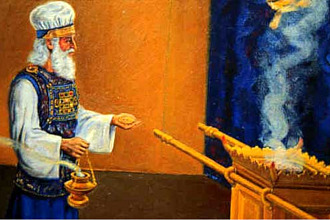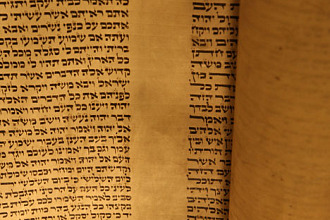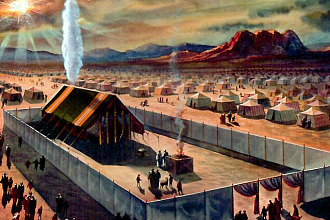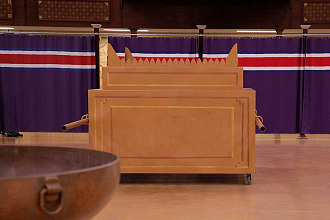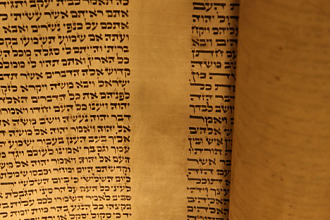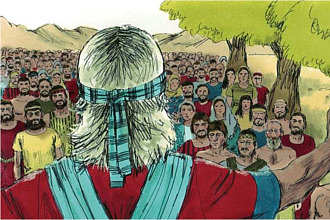Parasha for the Week: Pikudey: Exodus 38:21 – 40:38
Haftarah for the Week: 1 Kings 7:13 - 8:21
Apostolic Writings: Mark 16:2-20
The Book of Shemot concludes with this Parasha. After finishing all the different parts, vessels and garments used in the Mishkan, Moshe gives a complete accounting and enumeration of all the contributions and of the various clothing and vessels which had been fashioned. Bnei Yisrael bring everything to Moshe.
He inspects the handiwork and notes that everything was made according to G-d’s specifications.
Moshe blesses the people. G-d speaks to Moshe and tells him that the Mishkan should be set up on the first day of the first month, (Nissan). He also tells Moshe the order of assembly for the Mishkan and its vessels. Moshe does everything in the prescribed manner.
When the Mishkan is finally complete with every vessel in its place, a cloud descends upon it, indicating that G-d’s glory was resting there. Whenever the cloud moved away from the Mishkan, Bnei Yisrael would follow it. At night the cloud was replaced by a pillar of fire.
"INVENTORY OF THE MISHKAN"
The whole inventory of the Mishkan was entrusted to the care of Ithamar, son of Aaron. Rabbi Hirsch remind us that the details of the implementation of this general mission of the Levi'im are given later on: “Then Hashem spoke to Moses saying, “Gather the tribe of Levi near, and appoint them to attend to Aaron the kohen. They are to keep watch over duties for him and the entire community before the Tent of Meeting while performing the service of the Tabernacle. They are to tend to all the implements of the Tent of Meeting and the service of Bnei-Yisrael while performing the service of the Tabernacle. You are to give the Levites to Aaron and his sons. Out of Bnei-Yisrael they are dedicated entirely to him. You are to appoint Aaron and his sons to maintain the priesthood; any commoner who approaches must be executed.” (Numbers 3:5–10).
'THEY HAD DONE IT"
After describing the installation of the Sanctuary, Moses was happy with the work done by the people of Israel: “According to everything that Hashem had commanded Moses, Bnei-Yisrael had done all the work just so. When Moses saw the entire work, and that they had done it just as Hashem had commanded, Moses blessed them.” (Exodus 39:42–43). It is interesting here that Rabbi Hirsch noticed that Moses underline two characteristics of what has been done. 1. "They had done it", it was they who had done it; every part of the work, from the smallest to the largest, expressed the whole personality, the devotion, the enthusiastic responsiveness, and the dynamism of the entire nation. 2. not only "they had done it" but "just as Hashem had commanded" Their zeal and enthusiasm had been subordinated completely— both communally and individually— to the divine command.
Rabbi Hirsch give an other idea saying that "there had been no attempt on the part of any craftsman to bring his own ideas and his own individuality to bear upon the work by making additions or omissions" It is important here to notice this faithfulness of the people of Israel, because most of the commentaries we have about the people of Israel in the wilderness is negative, as if the people of Israel have always been unfaithful to God and rebellious people. Moses was so happy about their work, that he "blesses them" I cannot avoid to quote again Rabbi Hirsch who said: "This joy of duty eagerly fulfilled, this freedom in obedience and obedience in freedom, is experienced precisely when one subordinates himself entirely to G-d's will, which brings a sense of self-fulfillment and unsurpassed joy. This is the distinguishing characteristic of the highest moral perfection in the deeds of the Jewish person. That is what characterizes a human being as 'servant of G-d' [in Hebrew in the text]"
"THE PRESENCE OF G-D AMONG HIS PEOPLE"
The last chapter of Exodus is about the installation and dedication of the Sanctuary of the Wilderness, However, I would say that it just the beginning of the dedication ceremony, since this dedication will continue in the Leviticus with the ordination of Aaron and his sons. All these process of dedication and ordination will last for seven days. The verse starts with the date of the establishment of the sanctuary: “On the first day of the first month, you will set up the Tabernacle of the Tent of Meeting.” (Exodus 40:2) In the original Hebrew, there is a repetition which is not in our translation. The text says: "On the day of the first new moon, on the first of the month…" the "first new moon" is the first month, and then it is said, on the first day of that month. We know that the first month for the Israelite was the month of Nissan, the month of the Exodus and the month of Pesach. Passover will be celebrated on the 14th of Nissan that means exactly two weeks after the dedication of the Sanctuary. We need to say a few words here about the "New Moon" in the desert of Sinai, it was easy to look at the moon and the new moon as easily recognized every month, since it is very rare that the sky was cloudy there. everyone who has been in this desert to ascend the Mount Sinai, will agree with me that it never rain in this part of the world, that is why it is a desert. But in Israel it would not be the same, rain is coming upon the Promised Land very often, particularly on the period between Sukkot (October) and Pesach (April), thus it could be cloudy and would be difficult to wait for a witness to see the new moon. That is why already in the time of the Bible, the Jewish people was able to calculate the exact date of the new moon and to know when the month will start. We have a very good example of this, when David spoke to Jonathan, the text says: “So David said to Jonathan, “Look, tomorrow is the New Moon, when I am supposed to sit down with the king to eat.” (1 Samuel 20:5), David said: "tomorrow is the New Moon" never David would be able to say that if he did not know when the New Moon will occur, and if the New Moon would be declared only after a witness would see it. David knew exactly how to calculate the calendar and the month, and he knew that the morrow would be the New Moon or the first day of the month. On that day, David was invited to eat at the table of the king, because it was a day of celebration, the Jewish people were commanded to sanctify the New Moon, called in Hebrew "Kiddush Hachodesh." Thus the kings of Israel had a special ceremony in their palace on that special evening.
Hashem commanded to Moses: "you will set up the Tabernacle of the Tent of Meeting.” (Exodus 40:2) Through this establishment G-d's glory began to dwell on earth in the midst of the people of Israel. This would take place on the first month, that means at the beginning of the Israelite year. It was also the first month of the dwelling of the Shechinah or presence of G-d among Israel: “Then the cloud covered the Tent of Meeting, and the glory of Hashem filled the Tabernacle. Moses was unable to enter into the Tent of Meeting, because the cloud resided there and the glory of Hashem filled the Tabernacle.” (Exodus 40:34–35).
Haftara: 1 Kings 7:13 - 8:21
These eleven months of preparation (cf. last week comment) were also necessary to prepare the moving of the Ark of the Covenant, which was brought to Jerusalem by king David. Each one among the leaders who was involved in this dedication should prepare himself. It is written that Solomon gathered the “elders of Israel” that is the Sanhedrin, which was the high court of justice of Israel, and the Talmud specifically requires the presence of the High court for the dedication of the Temple (Shavuot 15a). Then the Ark of the covenant was ready to be moved in the Temple: “Then all the elders of Israel came and the kohanim brought up the ark. They brought up the ark of Hashem, the Tent of Meeting and all the holy vessels that were in the Tent the kohanim and the Levites brought them up.” (1 Kings 8:3–4). According to Numbers 7:9 one family among the Levites and Kohanim were assigned to carry the Ark of the Covenant, it was the family of Kehath the Kehathites. “to the sons of Kohath he did not give any because their responsibility was carrying the holy items on their shoulders.” (Numbers 7:9). However, there is a discussion among the Jewish scholars to know if the Ark was carried by Kohanim (Aaron descendants) or Levites (Kehathites) and this conversation is open because if the first book of kings mentioned the Kohanim, the second book of Chronicles says the Levites (5:4). If the Levites brought the Ark from its place on Mount Zion to the Temple on Mount Moriah, it is clear that it was the Kohanim who placed the Ark in the Most Holy place, since only them were allowed to enter in the Holy of Holies: “The kohanim brought the ark of the covenant of Hashem to its place, into the inner Sanctuary of the House, to the Holy of Holies, under the wings of the cheruvim.” (1 Kings 8:6). At long last, the Ark found its ultimate house, this Ark which was built in the time of Moses and which still had in it the tables of the Ten Commandments had been stationed in Gilgal, Shiloh and Nob, after the destruction of Nob in the time of Shaul, the Ark was put in Gibeon (I Chronicles 21:29) and king David decided to bring it to Jerusalem. The text says about the staves: “But the poles were so long that the ends of the poles were seen from the Holy Place before the inner Sanctuary, but they could not be seen outside; there they are to this day.” (1 Kings 8:8), these staves were 10 cubits long (5 meter or 16 feet), thus, the extremities of these staves were seen from the Holy Place (chamber before the Holy of Holies place) and as Moses commanded they were never removed from their rings.
The Ark was the centerpiece of the Temple, as it was in the Sanctuary and Tabernacle. The Ark which contains the 10 commandments, was the symbolic representation of the heart of every believer who is invited to study Torah all his life and to cherish the Ten Commandments as the summary of the 613 commandments God gave to his people, and the summary of the great moral laws which were pointed out by Yeshua, when he was asked which commandment is first of all, he answer with the Shema Israel saying: “The first is, ‘Shema Yisrael, ADONAI Eloheinu, ADONAI echad. And you shall love ADONAI your God with all your heart, and with all your soul, and with all your mind, and with all your strength.’ The second is this, ‘You shall love your neighbor as yourself.’ There is no other commandment greater than these.” (Mark 12:29–31), the two tables are summarized in a wonderful way here.
Apostolic Writings : Mark16:2 - 20
With parasha Pikudei we close the book of Shemot (Exodus) as we close today our reading of the Besorat of Mark. The book of Exodus ends with a glorious day for the people of Israel, the Shekhinah or the presence of God is coming upon the sanctuary. Mark 16 shows us a glorious day for the disciples who see Yeshua coming back from the dead and going to heaven.
The parasha affirms: “Thus all the work of the tabernacle of the tent of meeting was finished, and the people of Israel did according to all that the Lord had commanded Moses; so they did.” (Exodus 39:32), it is a beautiful text because we understand here that the people of Israel were not always disobedient, but they did everything according to God’s will.
The sanctuary was finished, all had been done as the Lord commanded. In the Besorah of Yochanan we read about Yeshua on the cross: “When Yeshua had received the sour wine, he said, ‘It is finished,’ and he bowed his head and gave up his spirit.” (John 19:30). At the construction of the sanctuary, the people did all according to God’s will. At the end of the earthly life of Yeshua when he was ready to die he said “it is finished” he finished what he had to do on the earth.
Not only the people of Israel did what the Lord commanded, but Moses too: “This Moses did; according to all that the Lord commanded him, so he did.” (Exodus 40:16) and thus the sanctuary was erected “In the first month in the second year, on the first day of the month, the tabernacle was erected. Moses erected the tabernacle.” (Exodus 40:17–18). The sanctuary is all about Yeshua, it is an illustration of his life, his ministry, his death, his resurrection and his heavenly ministry, that is why it is so important, we would say crucial to study the symbolism and meaning of the sanctuary.
In parallel with the erection of the sanctuary, Yeshua was raised from the death: “And very early on the first day of the week, when the sun had risen, they went to the tomb. And they were saying to one another, ‘Who will roll away the stone for us from the entrance of the tomb?’ And looking up, they saw that the stone had been rolled back—it was very large. And entering the tomb, they saw a young man sitting on the right side, dressed in a white robe, and they were alarmed. And he said to them, ‘Do not be alarmed. You seek Yeshua of Nazareth, who was crucified. He has risen; he is not here. See the place where they laid him.’” (Mark 16:2–6). The disciples were not ready to believe, they did not expect what would happen and they got afraid in this new situation: “And they went out and fled from the tomb, for trembling and astonishment had seized them, and they said nothing to anyone, for they were afraid.” (Mark 16:8).
In the parasha it is time for God to take possession of the sanctuary “Then the cloud covered the tent of meeting, and the glory of the Lord filled the tabernacle.” (Exodus 40:34). From that time God was with them, guiding them, helping them wherever they went, in order to be witnesses for God among all the nations of the promised land. The text says: “Throughout all their journeys, whenever the cloud was taken up from over the tabernacle, the people of Israel would set out. But if the cloud was not taken up, then they did not set out till the day that it was taken up. For the cloud of the Lord was on the tabernacle by day, and fire was in it by night, in the sight of all the house of Israel throughout all their journeys.” (Exodus 40:36–38), in parallel of the parasha, the Besorat of Mark also says that Yeshua sent them to the nations. “And he said to them, ‘Go into all the world and proclaim the gospel to the whole creation. Whoever believes and is baptized will be saved, but whoever does not believe will be condemned.’” (Mark 16:15). The disciples received the same power that moved Yeshua during his ministry on the earth. “And these signs will accompany those who believe” (Mark 16:16). This power was given to the disciples through the gift of the Ruach Hashem (the Holy Spirit). The Shekhinah which covered the sanctuary is the symbolic representation of the Ruach Hashem. Both, Israel and the disciples received the Ruach Elohim and were guided by God through the Ruach Hakodesh. “So then the Lord Yeshua, after he had spoken to them, was taken up into heaven and sat down at the right hand of God. And they went out and preached everywhere, while the Lord worked with them and confirmed the message by accompanying signs.” (Mark 16:19–20). This text of the Besorah is a summary of what happen between the resurrection and the ascension to heaven. A more detail narration is found in the first chapter of Acts of Apostles. There we learn, that he asked his talmidim to stay in Jerusalem until they receive a special power sent by God, the Ruach Hakodesh: “And while staying with them he ordered them not to depart from Jerusalem, but to wait for the promise of the Father, which, he said, “you heard from me; for John baptized with water, but you will be baptized with the Holy Spirit not many days from now.” (Acts 1:4–5), this Ruach Hakodesh came upon the earth at Shavuot, that means the 50th day after the Shabbat of Passover. They still had to learn many things, that is why they asked this question to Yeshua: “So when they had come together, they asked him, ‘Lord, will you at this time restore the kingdom to Israel?’”(Acts 1:6), Yeshua answered: “It is not for you to know times or seasons that the Father has fixed by his own authority. But you will receive power when the Holy Spirit has come upon you, and you will be my witnesses in Jerusalem and in all Judea and Samaria, and to the end of the earth.” (Acts 1:7–8). What is important now is not to know the future, what is important is to carry the mission to the world starting by Jerusalem and then going to the extremity of the earth. Then yeshua will come back and will establish this kingdom of God they were waiting for. Then a wonderful revelation is make to the disciples: “And when he had said these things, as they were looking on, he was lifted up, and a cloud took him out of their sight. And while they were gazing into heaven as he went, behold, two men stood by them in white robes, and said, ‘Men of Galilee, why do you stand looking into heaven? This Yeshua, who was taken up from you into heaven, will come in the same way as you saw him go into heaven.’”(Acts 1:9–11). Yeshua went to heaven, that is what we have seen in the Besorat of Mark, but not the text says that angels appeared to the Talmidim and announced that this same Yeshua who went to heaven will come back, and the text precises “will come in the same way as you saw him go into heaven” he will come back in the same way, that means Yeshua went to heaven personally, in a visible way, and in a glorious way, then we can expect at any time that the Messiah will come back personally, in a visible way and in a glorious manner. What a wonderful day, it will be when we will see Yeshua coming from heaven to take us in the house of his father, and fulfilling his promise “In my Father’s house are many rooms. If it were not so, would I have told you that I go to prepare a place for you? And if I go and prepare a place for you, I will come again and will take you to myself, that where I am you may be also.” (John 14:2–3).





